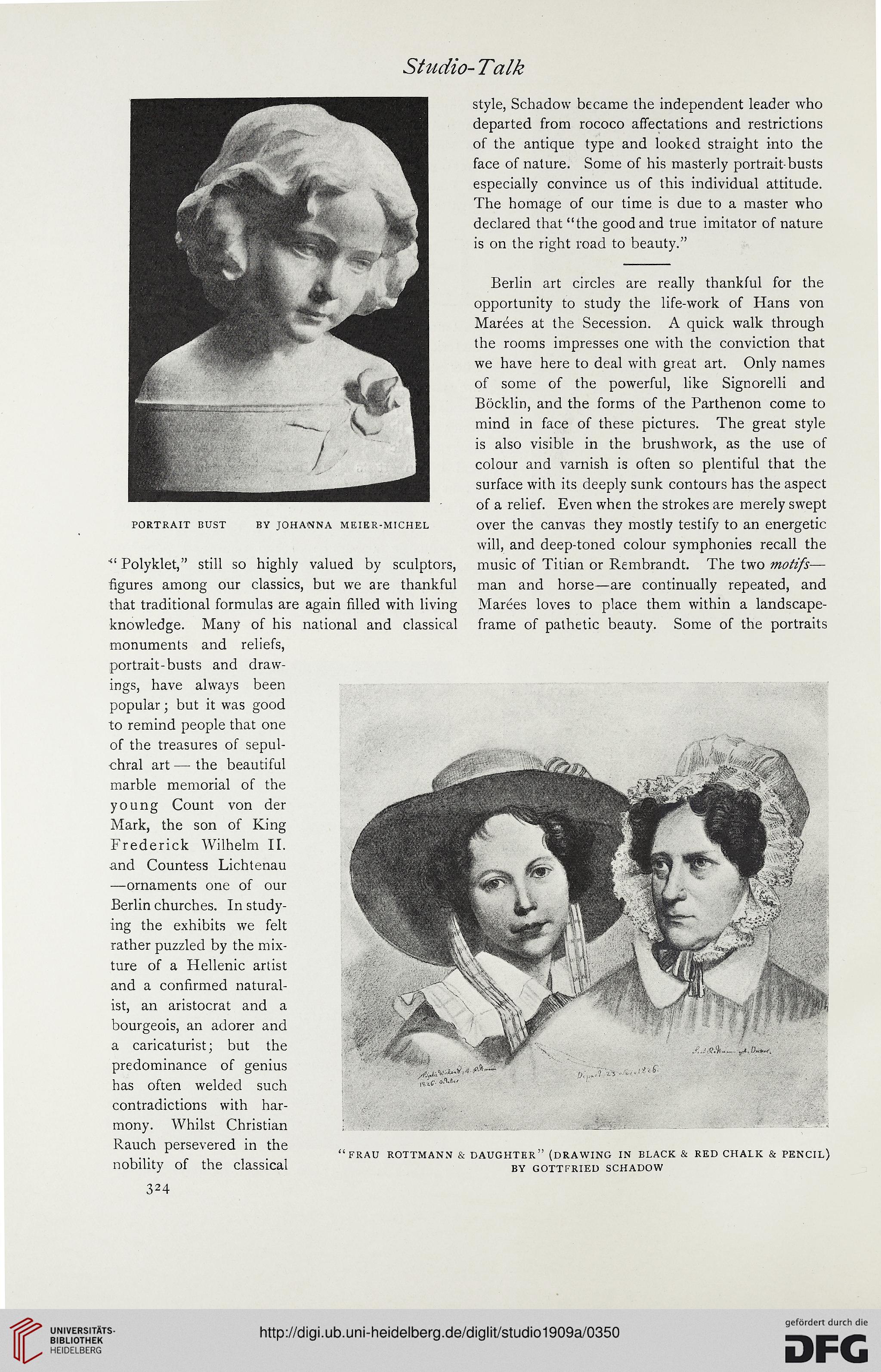Studio-Talk
PORTRAIT BUST BY JOHANNA MEIER-MICHEL
“ Polyklet,” still so highly valued by sculptors,
figures among our classics, but we are thankful
that traditional formulas are again filled with living
knowledge. Many of his national and classical
monuments and reliefs,
portrait-busts and draw-
ings, have always been
popular; but it was good
to remind people that one
of the treasures of sepul-
chral art —- the beautiful
marble memorial of the
young Count von der
Mark, the son of King
Frederick Wilhelm II.
and Countess Lichtenau
—ornaments one of our
Berlin churches. In study-
ing the exhibits we felt
rather puzzled by the mix-
ture of a Hellenic artist
and a confirmed natural-
ist, an aristocrat and a
bourgeois, an adorer and
a caricaturist; but the
predominance of genius
has often welded such
contradictions with har-
mony. Whilst Christian
Rauch persevered in the
nobility of the classical
324
style, Schadow became the independent leader who
departed from rococo affectations and restrictions
of the antique type and looked straight into the
face of nature. Some of his masterly portrait-busts
especially convince us of this individual attitude.
The homage of our time is due to a master who
declared that “the good and true imitator of nature
is on the right road to beauty.”
Berlin art circles are really thankful for the
opportunity to study the life-work of Hans von
Marees at the Secession. A quick walk through
the rooms impresses one with the conviction that
we have here to deal with great art. Only names
of some of the powerful, like Signorelli and
Bocklin, and the forms of the Parthenon come to
mind in face of these pictures. The great style
is also visible in the brushwork, as the use of
colour and varnish is often so plentiful that the
surface with its deeply sunk contours has the aspect
of a relief. Even when the strokes are merely swept
over the canvas they mostly testify to an energetic
will, and deep-toned colour symphonies recall the
music of Titian or Rembrandt. The two motifs—
man and horse—are continually repeated, and
Marees loves to place them within a landscape-
frame of pathetic beauty. Some of the portraits
“FRAU ROTTMANN & DAUGHTER” (DRAWING IN BLACK & RED CHALK & PENCIL)
BY GOTTFRIED SCHADOW
PORTRAIT BUST BY JOHANNA MEIER-MICHEL
“ Polyklet,” still so highly valued by sculptors,
figures among our classics, but we are thankful
that traditional formulas are again filled with living
knowledge. Many of his national and classical
monuments and reliefs,
portrait-busts and draw-
ings, have always been
popular; but it was good
to remind people that one
of the treasures of sepul-
chral art —- the beautiful
marble memorial of the
young Count von der
Mark, the son of King
Frederick Wilhelm II.
and Countess Lichtenau
—ornaments one of our
Berlin churches. In study-
ing the exhibits we felt
rather puzzled by the mix-
ture of a Hellenic artist
and a confirmed natural-
ist, an aristocrat and a
bourgeois, an adorer and
a caricaturist; but the
predominance of genius
has often welded such
contradictions with har-
mony. Whilst Christian
Rauch persevered in the
nobility of the classical
324
style, Schadow became the independent leader who
departed from rococo affectations and restrictions
of the antique type and looked straight into the
face of nature. Some of his masterly portrait-busts
especially convince us of this individual attitude.
The homage of our time is due to a master who
declared that “the good and true imitator of nature
is on the right road to beauty.”
Berlin art circles are really thankful for the
opportunity to study the life-work of Hans von
Marees at the Secession. A quick walk through
the rooms impresses one with the conviction that
we have here to deal with great art. Only names
of some of the powerful, like Signorelli and
Bocklin, and the forms of the Parthenon come to
mind in face of these pictures. The great style
is also visible in the brushwork, as the use of
colour and varnish is often so plentiful that the
surface with its deeply sunk contours has the aspect
of a relief. Even when the strokes are merely swept
over the canvas they mostly testify to an energetic
will, and deep-toned colour symphonies recall the
music of Titian or Rembrandt. The two motifs—
man and horse—are continually repeated, and
Marees loves to place them within a landscape-
frame of pathetic beauty. Some of the portraits
“FRAU ROTTMANN & DAUGHTER” (DRAWING IN BLACK & RED CHALK & PENCIL)
BY GOTTFRIED SCHADOW





